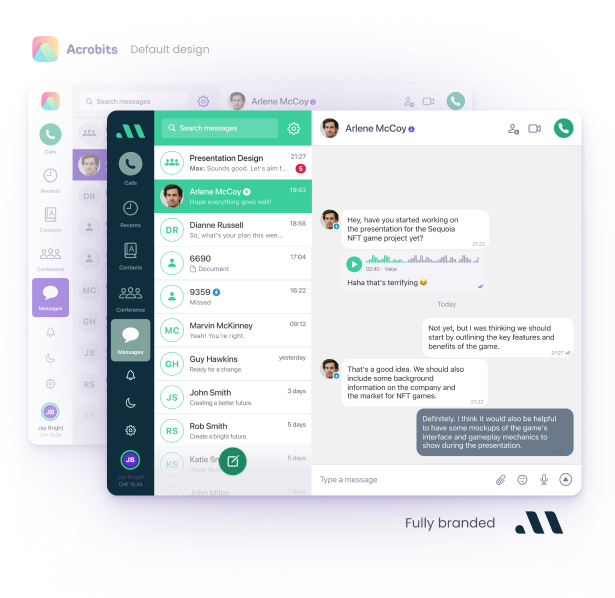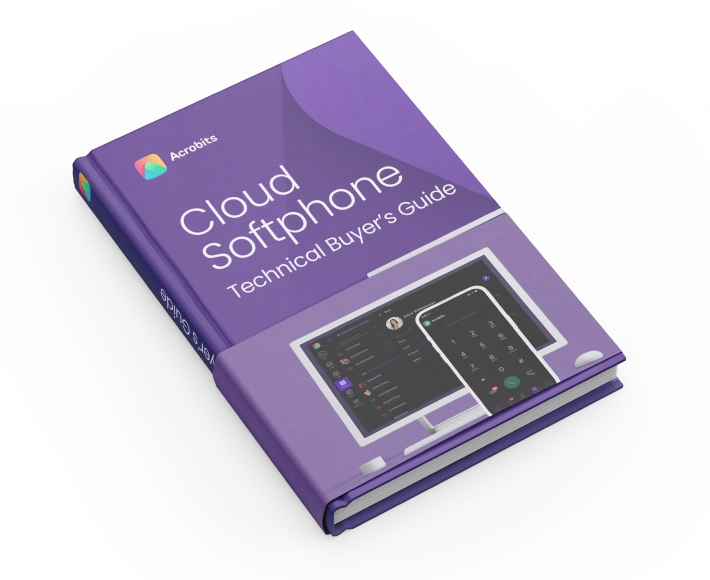
Build a white label softphone app
Create a custom white-label softphone with Cloud Softphone.
- No devs needed
- Native desktop apps
- 100+ premium features

As traditional hardware phones become outdated in today’s fast-evolving communications landscape, businesses are searching for solutions that deliver efficient communications while maintaining cost efficiency.
For CTOs, communication service providers, and telecom resellers, understanding when and why to adopt softphones is critical to staying competitive.
This article explores who truly benefits from switching from hardphones to softphones, highlighting their operational advantages, cost-effectiveness, and the mobility they unlock in modern business telephony.
A softphone is a software-based phone application that runs on internet-connected devices, enabling calls over the internet, instead of traditional telephony hardware. Unlike conventional desk phones that rely on physical connections and proprietary hardware, softphones leverage cloud-based telephony and SIP (Session Initiation Protocol) to facilitate calls.
Softphones work with your existing VoIP and UCaaS setup. Our complete softphone guide covers everything you need to know.
While softphones offer benefits across various sectors, industries such as hospitality, healthcare, and logistics stand out as prime candidates for adoption. These sectors demand flexible, mobile, and reliable communication tools to support dynamic workflows.
Moreover, businesses of all sizes, from SMBs to large enterprises, gain from the scalability and cost savings softphones provide, making them indispensable in modern business telephony.
One of the most compelling reasons to switch to cloud softphones is their cost-effectiveness compared to traditional desk phones. Let’s do some math first
Physical desk phones require capital expenditures of around $100-$300 per unit, not including installation fees, ongoing maintenance contracts, and eventual replacement every 3-5 years. For a business with 100 employees, that’s an upfront cost of $10,000-$30,000, plus annual maintenance costs that can exceed $50 per device.

In contrast, softphones operate on a subscription-based model, typically costing $2-$5 per user per month. Cloud Softphone starts at $0.05 per active user per month. There’s no hardware to install, and updates and maintenance are handled by the provider. This drastically reduces the total cost of ownership (TCO), and businesses can expect to save 30-60% annually by switching to cloud softphones.
Cloud softphone solutions offer rich, modern feature sets that go beyond what most hardware phones provide:
For CSPs and VoIP providers, delivering these capabilities through software-based phones enhances their value proposition. It allows them to offer custom-branded softphones, deliver updates over the air, and reach enterprise clients with highly differentiated solutions – without the costs and limitations of shipping hardware.
Unlike desk phones, softphones don’t require physical manufacturing, packaging, or global shipping-all of which contribute to carbon emissions and electronic waste. By going digital, companies can significantly reduce their environmental footprint.
In large-scale deployments, this shift can eliminate hundreds of kilograms of e-waste and avoid the energy costs tied to producing and distributing physical devices. Choosing softphones is not just a smart business move-it’s a more sustainable choice aligned with modern ESG goals.
Modern workflows demand communication tools that adapt to remote work, distributed teams, and rapid response scenarios. Softphones empower businesses with:
This agility is crucial for sectors like healthcare, where urgent communication can impact patient outcomes, or logistics, where real-time coordination drives operational efficiency.
For VoIP providers, MNOs, MVNOs, and telcos, the ability to tailor softphone solutions is a strategic advantage. SIP softphone customization enables providers to embed branding, tailor user interfaces, and integrate with proprietary systems.
Moreover, no-code softphone platforms empower CSPs to rapidly develop and deploy customized softphone applications without extensive software development cycles. This accelerates time-to-market and allows for agile responses to client requirements.
By offering customizable and easy-to-integrate softphone solutions, providers can address the unique challenges of diverse sectors, delivering enterprise VoIP solutions that align with specific workflows and compliance needs.
Transitioning to softphones is more than just swapping out hardware – it requires strategic planning and thoughtful execution to avoid disruption and unlock the full value of the combination of your current VoIP backend and softphones. Here are key areas to focus on:
It’s important to assess where you are before you set out on a journey. Therefore before rollout, businesses should audit their existing telephony infrastructure to identify dependencies, compatibility gaps, and opportunities for consolidation.
Example: A mid-sized enterprise can migrate 30% of its (ideally and if possible non mission critical) workforce in phase one, monitor performance for 2-3 weeks, then continue in waves-reducing risk while ensuring continuity.
Planning a smooth transition from legacy systems to softphone solutions?
Softphones are most valuable when they’re deeply integrated into your daily workflows.
Adoption hinges on user comfort. Even tech-savvy employees benefit from training that highlights:
Consider offering 30-minute onboarding sessions, video tutorials, and in-app tips to reduce support tickets and boost user confidence.
Security must be built-in-not bolted on. Softphones should support:
Choose vendors that can provide detailed security documentation and offer admin-level controls for policy enforcement.
Providers that proactively support clients through these steps-not just with software, but with planning, training, and integration assistance-can dramatically shorten the learning curve, reduce downtime, and accelerate ROI.
Softphones represent a transformative shift in business telephony, delivering cost-effective, feature-rich, and mobile communication solutions tailored for today’s agile enterprises.
From hospitality to healthcare and logistics, sectors that rely on flexible, reliable communications stand to gain the most. For CSPs and telecom resellers, leveraging SIP softphone customization and no-code platforms offers a compelling way to meet diverse client needs while simplifying deployment and management.
As a CTO or decision-maker, evaluating softphone integration and migration strategies now positions your organization to unlock enhanced operational agility and competitive advantage. Ready to explore how softphones can redefine your communication services?
Book a demo with Acrobits today and discover tailored softphone solutions designed for your enterprise VoIP needs.

Every telecom provider knows the appeal of a quick fix. Deploy a generic softphone app, get your users online, and move on. But as the market surges toward $400 billion by 2034, the cracks in this approach are becoming impossible to ignore. Scaling, branding, and innovation all hit a ceiling fast. The hidden cost of […]

Picture this: your softphone app aces every backend test, but users drop off after the first call. Why? Technical reliability alone won’t win the adoption game, intuitive onboarding, seamless UI, and robust call quality all matter equally. Testing and launching a softphone app is a two-front battle, and neglecting either side puts your brand and […]

Not every VoIP user needs the same thing. Some just want a rock-solid app to connect their SIP line. Others need to launch a white-label softphone under their own brand. Acrobits offers two very different tools to cover both ends of that spectrum: Groundwire and Cloud Softphone. Feature Groundwire Cloud Softphone Pricing $9.99 one-time purchase […]

For many small and medium-sized businesses, the traditional PBX (Private Branch Exchange) phone system has long been the backbone of daily communication. As remote work becomes the norm and digital transformation accelerates, these hardware-bound systems are increasingly feeling like a bottleneck: they are costly to maintain, inflexible, and ill-suited for modern workflows. If you’re an […]